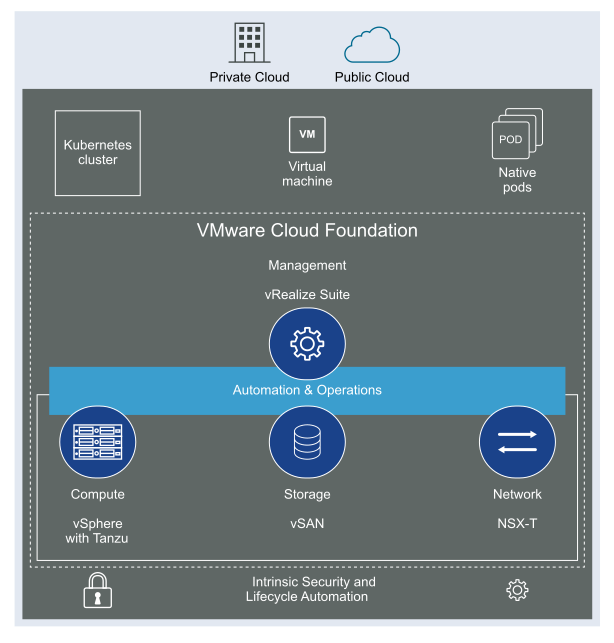VMware Cloud Foundation™ provides a ubiquitous hybrid cloud platform for both traditional enterprise and modern applications. Based on a proven and comprehensive software-defined stack including VMware vSphere® with VMware Tanzu™, VMware vSAN®, VMware NSX-T® Data Center, and VMware vRealize® Suite, VMware Cloud Foundation provides a complete set of software-defined services for compute, storage, network, container and cloud management. The result is agile, reliable, efficient cloud infrastructure that offers consistent operations across private and public clouds.

VMware Cloud Foundation enables data center cloud administrators to provision an application environment in a rapid, repeatable, automated way versus the traditional manual process.
To manage the logical infrastructure in the private cloud, VMware Cloud Foundation augments the VMware virtualization and management components with VMware Cloud Builder and VMware Cloud Foundation™ SDDC Manager™.
VMware Cloud Builder
VMware Cloud Builder automates the deployment of the software-defined stack, creating the first software-defined unit known as the management domain.
SDDC Manager
SDDC Manager automates the entire system life cycle, that is, from configuration and provisioning to upgrades and patching including host firmware, and simplifies day-to-day management and operations. From this interface, the virtual infrastructure administrator or cloud administrator can provision new private cloud resources, monitor changes to the logical infrastructure, and manage life cycle and other operational activities.
vSphere
vSphere uses virtualization to transform individual data centers into aggregated computing infrastructures that include CPU, storage, and networking resources. VMware vSphere manages these infrastructures as a unified operating environment and provides you with the tools to administer the data centers that participate in that environment.
The two core components of vSphere are ESXi and vCenter Server. ESXi is the virtualization platform where you create and run virtual machines and virtual appliances. vCenter Server is the service through which you manage multiple hosts connected in a network and pool host resources.
By using the integration between VMware Tanzu and VMware Cloud Foundation, you can deploy and operate the compute, networking, and storage infrastructure for vSphere with Tanzu, also called Workload Management. vSphere with Tanzu transforms vSphere to a platform for running Kubernetes workloads natively on the hypervisor layer. When enabled on a vSphere cluster, vSphere with Tanzu provides the capability to run Kubernetes workloads directly on ESXi hosts and to create upstream Kubernetes clusters within dedicated resource pools.
vSAN
vSAN aggregates local or direct-attached data storage devices to create a single storage pool that is shared across all hosts in the vSAN cluster. Using vSAN removes the need for external shared storage, and simplifies storage configuration and virtual machine provisioning. Built-in policies allow for flexibility in data availability.
NSX-T Data Center
NSX-T Data Center is focused on providing networking, security, automation, and operational simplicity for emerging application frameworks and architectures that have heterogeneous endpoint environments and technology stacks. NSX-T Data Center supports cloud-native applications, bare-metal workloads, multi-hypervisor environments, public clouds, and multiple clouds.
vRealize Suite Lifecycle Manager
VMware Cloud Foundation supports automated deployment of vRealize Suite Lifecycle Manager. You can then deploy and manage the life cycle of Workspace ONE Access and the VMware vRealize Suite products (vRealize Log Insight, vRealize Automation, and vRealize Operations Manager) by using vRealize Suite Lifecycle Manager.
vRealize Suite is a purpose-built management solution for the heterogeneous data center and the hybrid cloud. It is designed to deliver and manage infrastructure and applications to increase business agility while maintaining IT control. It provides the most comprehensive management stack for private and public clouds, multiple hypervisors, and physical infrastructure.